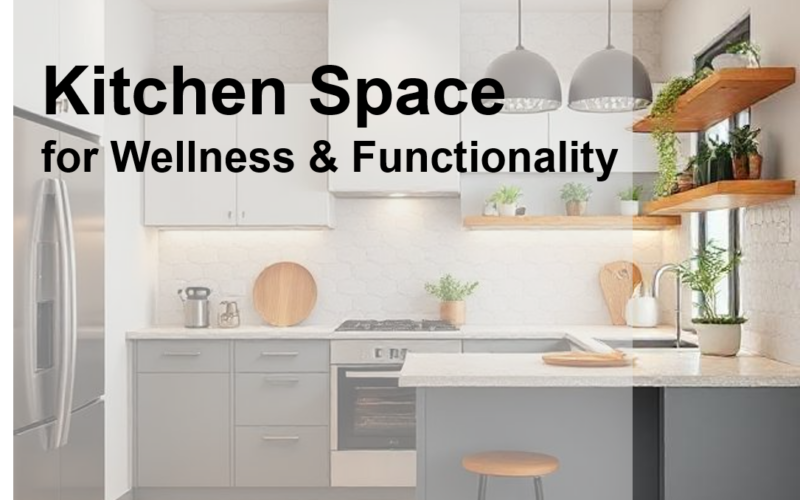How to Enhance Kitchen Space for Wellness and Functionality

Introduction
The kitchen is more than just a place for cooking—it’s the heart of the home where nourishment, creativity, and connection come together. A well-designed kitchen fosters wellness, encourages mindful eating, and improves overall functionality. Whether you have a compact space or a spacious kitchen, optimizing it for efficiency and well-being is crucial.
In this guide, we’ll explore practical strategies to enhance kitchen space for wellness and functionality, from smart layouts to sustainable materials and ergonomic solutions.
Understanding the Connection Between Kitchen Design and Well-being
A well-planned kitchen directly impacts physical and mental well-being. Factors such as organization, lighting, ventilation, and material choices contribute to a healthier cooking and dining experience. Here’s how:
- Reduces Stress: A clutter-free, well-organized kitchen fosters a calm and inviting atmosphere.
- Encourages Healthy Eating: A thoughtfully designed kitchen makes meal preparation easier, promoting healthier food choices.
- Improves Safety: Proper spacing and ergonomic design minimize accidents and strain while cooking.
Space Planning for Maximum Efficiency
A functional kitchen layout ensures smooth workflow and enhances productivity. Consider these key elements:
The Kitchen Work Triangle
The work triangle consists of three main kitchen zones: the sink, stove, and refrigerator. Ensuring these areas are easily accessible enhances efficiency. Key principles:
- Maintain a clear path between the three workstations.
- Allow at least 4 to 9 feet of spacing between them.
- Avoid placing obstacles like large furniture or appliances in this area.
Maximizing Small Kitchen Spaces
For compact kitchens, space optimization is essential:
- Use vertical storage: Install shelves, hanging racks, and magnetic knife holders to free up counter space.
- Multi-purpose furniture: Consider foldable tables, pull-out pantry shelves, and stackable storage containers.
- Declutter regularly: Keep only essential tools and appliances to maintain a tidy kitchen.
Enhancing Natural Light and Ventilation
Proper lighting and airflow are critical for a healthier and more functional kitchen.
Natural Lighting
Maximize natural light to reduce energy consumption and create a warm, inviting space:
- Install larger windows or skylights.
- Use light-colored cabinetry and countertops to reflect light.
- Place mirrors or glossy backsplashes strategically to enhance brightness.
Improving Ventilation
A well-ventilated kitchen prevents odors, smoke, and humidity buildup:
- Install a range hood to remove cooking fumes.
- Use open shelving to improve air circulation.
- Add indoor plants like aloe vera and snake plants to enhance air quality.
Choosing Wellness-Focused Materials and Finishes
Opting for non-toxic, durable, and eco-friendly materials is essential for a wellness-centric kitchen.
Countertops and Flooring
- Quartz or recycled glass countertops: Low-maintenance, durable, and non-porous.
- Bamboo or cork flooring: Sustainable and comfortable for prolonged standing.
- Low-VOC paints and sealants: Reduce harmful chemical emissions.
Cabinetry and Backsplashes
- Solid wood or MDF cabinets: Choose non-toxic, formaldehyde-free options.
- Ceramic or glass tile backsplashes: Easy to clean and aesthetically pleasing.
Smart Technology for a Functional and Healthier Kitchen
Integrating smart appliances and automation enhances convenience and sustainability.
Smart Appliances
- Touchless faucets: Reduce the spread of germs and conserve water.
- Energy-efficient refrigerators: Maintain optimal food freshness and reduce energy consumption.
- Smart cooking devices: Air fryers, instant pots, and smart ovens optimize cooking time and efficiency.
Automation & Sustainability
- Install motion-sensor lights to save electricity.
- Use composting bins for food scraps to reduce waste.
- Set up smart thermostats to regulate indoor temperature efficiently.
Incorporating Nature: Plants and Indoor Gardening
Bringing nature into the kitchen enhances air quality and promotes relaxation.
Best Air-Purifying Plants
- Aloe Vera: Absorbs pollutants and is easy to maintain.
- Spider Plant: Helps remove carbon monoxide and toxins.
- Herbs like basil, mint, and rosemary: Provide fresh ingredients for cooking.
Setting Up an Indoor Herb Garden
- Use hanging planters or vertical garden racks.
- Place plants near sunlit windows for optimal growth.
- Opt for self-watering planters to reduce maintenance.
Decluttering and Minimalist Kitchen Design
A minimalist approach fosters clarity, efficiency, and peace of mind.
Decluttering Tips
- Follow the “One-Year Rule”: If you haven’t used an item in a year, donate or recycle it.
- Invest in multi-functional tools: Minimize single-purpose gadgets.
- Organize in zones: Store items based on usage frequency.
Benefits of a Minimalist Kitchen
- Less cleaning time: Fewer items mean easier maintenance.
- Increased productivity: A tidy space boosts efficiency and focus.
- More enjoyment: Cooking in a clutter-free kitchen is more enjoyable.
Sustainable and Eco-Friendly Practices
A kitchen that promotes sustainability contributes to environmental wellness.
Reducing Waste
- Use reusable containers instead of single-use plastics.
- Compost food scraps to enrich soil and reduce landfill waste.
- Choose energy-efficient appliances to lower electricity usage.
Eco-Friendly Cooking Practices
- Opt for induction cooktops over gas stoves to reduce emissions.
- Use glass or stainless-steel cookware for longevity and safety.
- Plan meals to minimize food waste and excess consumption.
Final Touches: Creating a Mindful Cooking Environment
A mindful kitchen enhances the joy of cooking and promotes relaxation.
Setting the Ambiance
- Soft lighting: Use warm-toned LED lights for a cozy atmosphere.
- Aromatherapy: Essential oils like lavender and citrus boost mood and freshness.
- Calming sounds: Play soothing background music while cooking.
Dedicated Wellness Corner
- Create a tea or smoothie bar with easy access to healthy beverages.
- Include a comfortable seating area for mindful meals and conversations.
Transforming your kitchen into a space that promotes wellness and functionality requires thoughtful planning and mindful choices. By incorporating efficient layouts, natural elements, smart technology, and sustainable practices, you create a space that not only enhances cooking experiences but also supports a healthier lifestyle.
Take a moment to evaluate your kitchen—what small change can you make today to improve its functionality and wellness? Start with one upgrade and gradually incorporate more improvements for a complete transformation.



